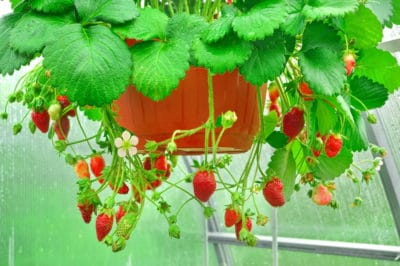About Hanging Strawberry Planters
A hanging strawberry planter can be as simple as a basket, but the classic planter is a tube you fill with soil and hang from a beam or stout hook. The tube may be made of heavy plastic, canvas or polypropylene fabric. The bag is either made with planting holes or you cut them into it. A heavy-duty rim, usually made of metal, has spots to secure chains to hang the planter.
Choose the Right Site
Strawberries need sun. Make sure you place your planter in a spot that gets at least six and preferably eight to 10 hours of full sun each day. The area under the tube should be able to tolerate splashing or dripping water and a bit of mud. Make sure you have a good, stout support to hang your tube from – the combination of soil, plants and water is surprisingly heavy.
Varieties to Try
Pretty much any strawberry will do well in a hanging planter, although the ones with runners tend to make for a more attractive look. June-bearing varieties will produce more fruit. These are readily available:
- Albion
- Alpine
- Cabot
- Chandler
- Dunlap
- Earliglow
- Jewel
- Ozark Beauty
- Sparkle
- Surecrop
- Tristar.
Soil and Fertilizer
Don’t try to use regular garden soil for your strawberry planter – once it gets wet it will be much too heavy. A commercial potting soil mixed with organic compost or just plain compost is a better choice. Since the plants are perennial and will be limited to nutrients in the bag, you’ll need to fertilize. A slow-release 10-10-10 organic fertilizer mixed in at planting is a good start.
Watering
Your strawberries need regular water to grow and produce well. Hanging tubes and baskets are exposed to drying winds, so check frequently and water when needed. Manure tea or liquid fertilizer lets you cover watering and feeding at the same time. Water slowly; the soil should drain well but that means water needs time to soak in.
Dealing with Runners
Strawberries reproduce by growing runners that root and form new plants. You can cut them off, which channels all the plant’s energy to the mother plant. You can root them in a new hanging planter and double your crop. Or you can just let them dangle – they’ll produce fruit the next year. Replace your strawberry plants every three years for best production.
